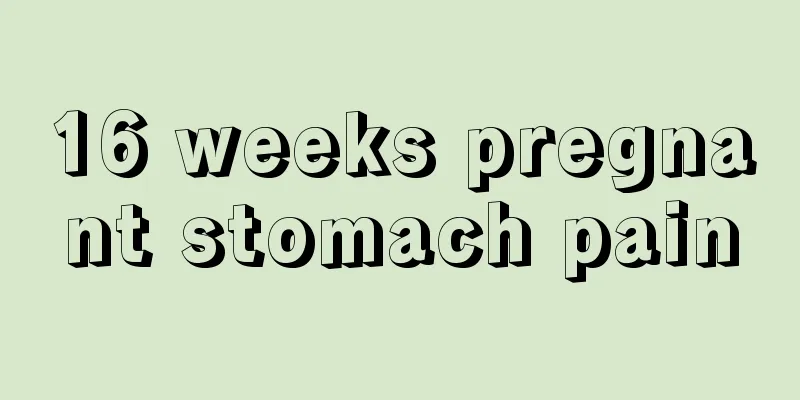How long does it take for a woman to have her period after giving birth?

|
A healthy body is very important for everyone, especially for women. For normal women, there is a physiological cycle every month. Menstruation is also an important factor symbolizing women's physical health. However, women's bodies will undergo great changes after giving birth, and the body also needs a certain amount of time to recover. In order to dispel women's concerns about postpartum menstruation, let's take a look at how long it takes for women to have their periods after giving birth. How long does it take for a woman to have her period after giving birth? From a medical point of view, based on the tissue morphology of the endometrium, the ovaries may be able to ovulate as early as 33-42 days after delivery. In addition, the presence of a corpus luteum after ovulation can also be observed 6 weeks after delivery. Therefore, if the mother does not breastfeed, menstruation usually comes within 6 to 8 weeks after delivery. Research data show that 40% of non-breastfeeding mothers resume ovulation 6 weeks after delivery; by 8-12 weeks after delivery, only about 35% of mothers have not resumed ovulation and menstruation. About 25% of breastfeeding mothers will resume ovulation and menstruation 12 weeks after delivery, and most breastfeeding mothers usually take until 18 weeks to fully resume ovulation function. However, it is sometimes difficult to clinically determine the exact time of the first menstrual period after delivery, and a small number of women will begin to have intermittent bleeding of small to moderate amounts immediately after delivery. For new mothers who breastfeed their babies, ovulation and menstruation will resume later, and some may not have their period until a year later. For most people, their first menstrual period is heavier than usual, but their second period becomes normal, so no treatment is needed. When menstruation comes, the amount of milk a breastfeeding mother produces generally decreases, and the quality of the protein and fat in the breast milk also changes slightly, with the protein content being higher and the fat content being lower. This milk sometimes causes indigestion symptoms in babies, but this is a temporary phenomenon and will return to normal after the menstrual period. Therefore, mothers do not need to stop breastfeeding whether during or after menstruation. 【Tips】 Postpartum lochia is not menstruation. Normally, after giving birth, a woman will have a bloody discharge from the birth canal, similar to menstruation. This bleeding from the placenta implantation site, mixed with secretions such as the decidua, tissue fragments, and mucus remaining in the uterus, is called lochia. Under normal circumstances, in the first 4 to 5 days, the lochia is abundant and red in color; one week after delivery, the amount of lochia gradually decreases and turns brown; after the 10th day, the color becomes lighter, slowly turning from yellow to white, and there is no special smell. Lochia usually disappears 4-6 weeks after delivery. But sometimes a small amount of brown lochia will continue until the first menstrual period after delivery. Lochia generally does not exceed the amount of menstruation. If bleeding continues for more than two weeks, exceeds menstrual volume or contains blood clots, or the vaginal discharge appears as rotten meat-like tissue or has a foul odor, you should seek medical attention immediately. The above is an introduction to how long it takes for menstruation to come after childbirth. After understanding it, we know that there is no fixed time for menstruation after childbirth. After all, everyone's physical constitution and physical condition are different, so there is no fixed time for menstruation after childbirth. Therefore, female friends should not worry too much. They should also pay attention to their body recovery after childbirth, try to get more rest after childbirth, and pay attention to a balanced diet. |
<<: Is it normal for a pregnant woman to have a hard belly?
>>: What are the reasons why women have many dreams when they sleep?
Recommend
Where is the source of the Yangtze River and where is its end? Why is the Yangtze River not the mother river?
The Yangtze River is the world's largest hydr...
Vulva acne and a little itchy
The pain in the vulva is mainly caused by inflamm...
It may be lurking around you! Beware of fake alcohol that can harm people
Mr. Wang usually likes to drink and has a few cup...
SensorTower: TikTok (the overseas version of Douyin) had nearly 67 million installations in November 2019
In November, TikTok (the overseas version of Douy...
What housework can you do during confinement?
Women need to stay in confinement after giving bi...
How many days after pregnancy can you use test strips to detect
As long as we have sex, there is a possibility of...
Can I go out 30 days after giving birth?
Women usually stay at home for a month after givi...
Five groups of people are prone to calcium deficiency. Can blood calcium test determine calcium deficiency? How to supplement calcium correctly?
Author: Qu Tiebing, Chief Physician, Beijing Boai...
What should I do if I experience dizziness and tachycardia after taking antihypertensive drugs?
A friend left a message for Huazi, saying that af...
What to do if you have severe sweating during menopause
In fact, when menopause comes, the physical fitne...
Woman with water flowing down her back
Women who have had sexual experience should know ...
What is the most feared thing about women's lower body?
Vaginitis is a gynecological inflammation that is...
Is vulvar dystrophy the same as vulvar leukoplakia?
Many female friends cannot distinguish between vu...
What can you eat to slow down brain aging?
September is not only the start of the school yea...









